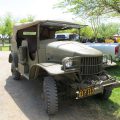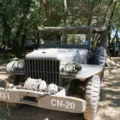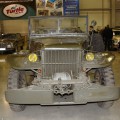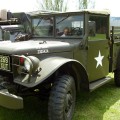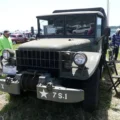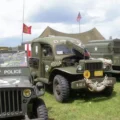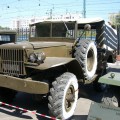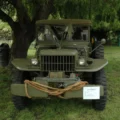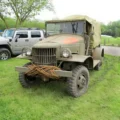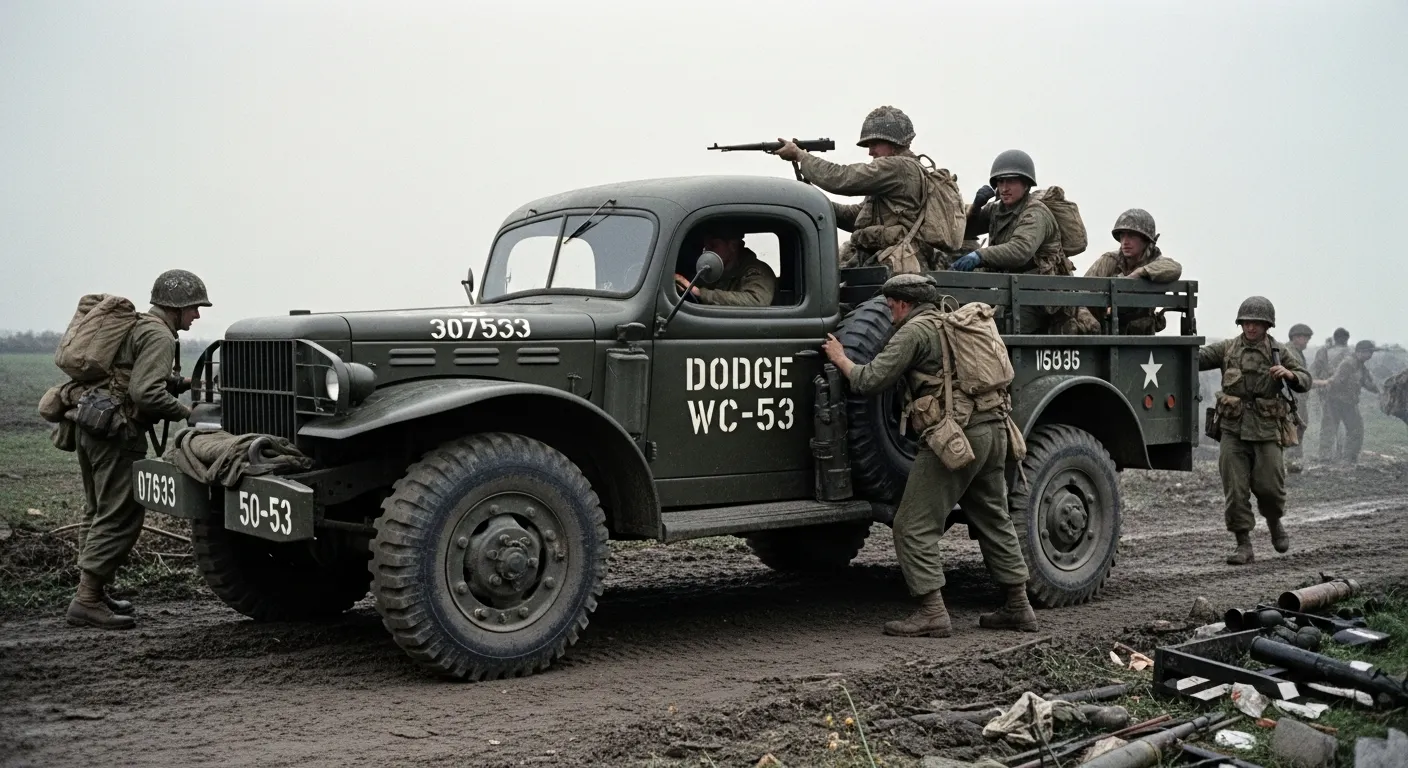
Dodge WC-53 |
|
|---|---|
| País | Eua |
| Tipo |
Caminhão leve 4×4 |
| Fabricante | Dodge (Chrysler) |
A carryall, mechanically the WC-53 was virtually identical to the WC-54 but was fitted with a body which was the 1939 civilian carryall modified to military specifications. All four rear side windows were wind-up opening and the seating consisted of front folding passenger seat to allow rear access, two person second row leaving space to access to the rear full width three person seat. The spare wheel was carried on a mount on the driver’s side and although the door was fully operational it could not be opened and the driver had to enter from the passenger side. The rear end had a horizontally split tailgate
Fonte: Dodge WC-53 na Wikipedia
| Dodge WC-53 Carryall Walk Around | |
|---|---|
| Fotógrafo | Desconhecido |
| Localização | Desconhecido |
| Fotos | 21 |
Wait, Searching Dodge WC-53 photos for you…

The Dodge WC-53 Carryall: A Comprehensive Historical and Technical Analysis
The Dodge WC series represented a prolific and indispensable range of light 4WD and medium 6WD military utility trucks during World War II. Manufactured by Chrysler under the Dodge and Fargo marques, these vehicles served as a critical complement to the lighter 1/4-ton Jeeps produced by Willys and Ford, collectively forming the backbone of the U.S. military’s light 4WD fleet. Dodge alone contributed approximately 337,500 4WD units to the war effort, underscoring its significant role in military logistics. The strategic deployment of the WC series alongside Jeeps illustrates a deliberate logistical approach during World War II. While Jeeps, with their 1/4-ton capacity, excelled in agile reconnaissance and light transport, the WC series, spanning 1/2-ton, 3/4-ton, and 1 1/2-ton payloads, provided essential capabilities for heavier cargo, troop transport, and specialized roles such as ambulances and command vehicles. Dodge’s designation as the sole supplier of both 3/4-ton and 1 1/2-ton trucks to the U.S. Army highlights the critical reliance placed on the company for medium-utility transport, effectively bridging the gap between light Jeeps and larger, heavy-duty trucks. This layered approach to military transport ensured that diverse operational requirements, from frontline mobility to rear-area supply and command, were met with optimized vehicle types, enhancing overall efficiency and resource allocation. The WC-53, specifically designated as a “Carryall” or “Special Command Field Sedan,” emerged as a specialized variant within the highly standardized 3/4-ton WC series. A common misconception attributes the “WC” designation to “Weapons Carrier.” However, historical records clarify that “WC” was a standard Dodge model code: “W” for 1941 and “C” for a nominal half-ton payload rating. This nomenclature was pragmatically retained even for the heavier 3/4-ton and 1 1/2-ton models developed later. The continuation of this initial code, despite its literal inaccuracy for later, heavier models, reflects a practical approach to wartime manufacturing and designation, prioritizing administrative continuity and familiarity over precise descriptive accuracy. This decision simplified logistical processes and avoided the complexities of introducing entirely new naming conventions during a period of rapid production and deployment. This report will provide a comprehensive analysis of the Dodge WC-53, delving into its development, unique design features, technical specifications, operational deployment during WWII, and its lasting legacy in the post-war era, including its appeal to collectors and the evolution of its design into civilian vehicles.Development and Production Overview
The Dodge WC series originated from the earlier VC series, with the WC-1 commencing production in 1941. A cornerstone of the WC series’ design philosophy was an emphasis on standardization and extensive commonality of parts across its numerous variants. This approach was crucial for simplifying field maintenance and ensuring operability in diverse and often challenging combat environments. By adhering to this principle, Dodge achieved an “extraordinary feat of the WWII American auto industry”, producing a wide array of vehicles, from 1/2-ton to 1 1/2-ton, with significant component interchangeability. This allowed for streamlined supply chains, reduced the variety of spare parts required, and facilitated repairs, directly contributing to the U.S. Army’s ability to sustain its vast vehicle fleet and maintain combat readiness. In 1942, the WC trucks underwent a substantial redesign, incorporating heavier frames and strengthened drivetrains to increase their payload capacity to 3/4-ton for off-road operations, leading to the designation as the G-502 series. The WC-53 Carryall was an integral part of this uprated 3/4-ton series, with its production commencing in 1942. However, its manufacturing run was relatively brief, ceasing in April 1943. A total of 8,400 WC-53 units were produced during its limited operational lifespan. This production figure represents a comparatively small fraction of the overall 3/4-ton WC series, which saw over a quarter-million units (ranging from 255,193 to 256,412) delivered between April 1942 and August 1945. The vast majority of the 3/4-ton production comprised the WC-51 and WC-52 Weapons Carriers, which were the most common variants. The quantitative disparity in production volumes immediately indicates that the WC-53 was not intended as a general-purpose vehicle like its Weapons Carrier counterparts. Its specialized role, as detailed in its design and purpose, directly correlates with its limited production volume. The early cessation of its production, while other 3/4-ton variants continued until 1945, foreshadowed the operational limitations and strategic re-evaluation that would ultimately define its wartime utility. This illustrates the dynamic nature of wartime vehicle development, where designs were quickly adapted or phased out based on evolving field performance and requirements.Design and Technical Specifications
The Dodge WC-53 distinguished itself from other military vehicles of its era through its unique “civilian-type, panel-van body work”. This enclosed design provided a more refined and protected interior environment compared to the open-cab cargo trucks prevalent in military service, aiming to offer enhanced enclosed transportation for military personnel. Interior Features: The WC-53 Special, a more elaborately equipped version, was designed with a focus on command and staff operations. It featured conventional side doors, a dedicated map table for tactical planning, specialized interior lighting, and an integrated radio for communication. For additional storage, a roof rack was fitted. A critical feature for its intended role as a mobile headquarters was the inclusion of blackout blinds in the rear windows, allowing for covert operations and secure discussions in the field. The vehicle’s design also incorporated lower sides for bucket seats, a subtle but practical detail intended to facilitate easier entry and exit for its occupants. Furthermore, the WC-53 Special was identifiable by its side-hinged rear door, a distinguishing characteristic compared to the standard WC-53 carryall version, which typically featured a top-hinged rear door. Engine and Drivetrain: Powering the WC-53 was the robust Dodge T214 side-valve, liquid-cooled, in-line six-cylinder gasoline engine. This engine, displacing 230 cubic inches (approximately 3.77 liters), produced 92 horsepower. The use of a straight-six Chrysler flathead gasoline engine was characteristic across the entire WC series, reflecting Chrysler’s standardized approach to military vehicle powerplants. The transmission was a four-speed forward, one-speed reverse manual unit. It is important to note that the original transmission was a “find and grind” non-synchronized “crashbox”. This type of transmission required drivers to manually match engine RPMs to gear speeds through a technique known as double-clutching, making operation more demanding and less forgiving than modern synchronized systems. The vehicle utilized a single-range transfer case, offering part-time four-wheel drive capability. Dimensions, Weight, and Performance: The WC-53’s physical characteristics were substantial for its class:- Length: 15 feet, 11 inches.
- Width: 6 feet, 10-1/2 inches.
- Height: 7 feet, 2 inches.
- Wheelbase: 114 inches. While some general WC series carry-alls were designed with a 116-inch wheelbase, the WC-53’s specific wheelbase was slightly shorter at 114 inches.
- Weight: The vehicle had an unladen weight of 5,750 pounds.
- Fording Depth: It was capable of traversing water obstacles up to 34 inches deep.
- Top Speed: The 3/4-ton WC series generally achieved a maximum speed of approximately 53-55 mph (85 km/h). However, operational reports indicated that driving at speeds exceeding 45 mph could cause the front end to “float,” significantly affecting stability and control. This practical limitation meant that while the vehicle could theoretically reach higher speeds, sustained travel at such velocities was often impractical or unsafe in field conditions.
- Other Specifications: The WC-53 was equipped with hydraulic brakes for effective stopping power. Consistent with its role as a staff and command vehicle rather than a combat platform, it was not fitted with factory-installed armor or armament.
Table 1: Dodge WC-53 Key Technical Specifications
| Especificação | Detail |
| Fabricante | Dodge (Chrysler) |
| Production Year | 1942 |
| Motor | Dodge T214 side-valve, 230-cid (3.77L), 92-hp, liquid-cooled, in-line six-cylinder, gasoline |
| Transmission | Four-speed forward, one-speed reverse manual (non-synchronized “crashbox”) |
| Transfer Case | Single-range, part-time four-wheel drive |
| Brakes | Hydraulic |
| comprimento | 15 feet, 11 inches (4.85 m) |
| Largura | 6 feet, 10-1/2 inches (2.09 m) |
| altura | 7 feet, 2 inches (2.18 m) |
| Wheelbase | 114 inches (2.90 m) |
| peso | 5,750 pounds (2,608 kg) |
| Fording Depth | 34 inches (0.86 m) |
| Top Speed | Approximately 53-55 mph (85 km/h) (practical limit, with front-end float above 45 mph) |
| Armor/Armament | None |
Operational Deployment and Wartime Utility
The Dodge WC-53 was initially conceived and intended for a specialized role within the U.S. Army: to serve as a “field sedan” or “special command field sedan” for staff officers and formation commanders. Its design, featuring an enclosed body, interior amenities like a map table and radio, and blackout blinds, clearly aimed to facilitate its use as a mobile headquarters. This vision positioned it as a comfortable and functional command post for high-ranking personnel, offering a degree of refinement and protection not found in open-cab vehicles. However, the realities of wartime deployment quickly revealed a significant discrepancy between its intended design and its practical utility in the field. The U.S. Army determined that the WC-53 Special was “too conspicuous for combat areas”. Its distinct civilian-type panel-van body made it easily identifiable by enemy forces, rendering it “vulnerable to enemy aircraft strafing”. Furthermore, its “top-heavy body also made it unsuited for cross-country use”, limiting its effectiveness in the rugged and unpredictable terrains of combat zones. This inherent design compromise meant that a vehicle optimized for specialized command functions inadvertently created vulnerabilities in a military context, leading to a critical re-evaluation of its role. Consequently, the WC-53’s actual deployment shifted significantly. The “carryall version,” which lacked some of the specialized fittings of the “Special” variant, was primarily “used solely as a utility vehicle in rear areas”. On European roads, the WC-53 Carryall became a “familiar beast of burden,” primarily utilized for “urgently supply[ing] units in the field, notably food and ammunitions”. This relegation to rear-area utility and supply roles, rather than frontline command, was a direct consequence of its design flaws. The early cessation of its production in April 1943, while other more versatile 3/4-ton variants continued, further underscores the Army’s rapid adaptation to battlefield feedback. This divergence between the WC-53’s intended purpose and its actual operational use highlights a fundamental paradox in the development of specialized wartime vehicles. While its unique features were designed to enhance command capabilities, these very elements contributed to its distinct appearance and limited tactical flexibility. A vehicle conceived for a high-value, niche role was ultimately deemed too vulnerable for that role in forward areas. Its subsequent re-tasking to more general rear-area utility demonstrated that in the crucible of war, versatility and survivability often superseded highly specialized, less robust designs. The experience with the WC-53 underscored the critical need for military vehicles to be not only functional but also adaptable and survivable in dynamic combat environments.Table 2: Dodge WC Series 3/4-Ton Variants and Production Numbers
The following table contextualizes the WC-53’s production volume within the broader 3/4-ton WC series, illustrating its relatively specialized and limited role compared to other, more widely produced variants.| Model Number | Descrição | Número construído | Production Years |
| WC-51 | Cargo Truck (Weapons Carrier) | 123,541 | 1942-1945 |
| WC-52 | Cargo Truck (Weapons Carrier, w/ Winch) | 59,114 | 1942-1945 |
| WC-53 | Carryall | 8,400 | 1942 – April 1943 |
| WC-54 | Ambulância | 26,002 | 1942 – April 1944 |
| WC-55 | Gun Motor Carriage M6 | 5,380 | April 1942 – Oct 1942 |
| WC-56 | Command and Reconnaissance Car | 21,156 | 1942-1944 |
| WC-57 | Command and Reconnaissance Car (w/ Winch) | 6,010 | 1942 – April 1944 |
| WC-58 | Radio Truck | 2,344 | 1942 |
| WC-59 | Telephone Maintenance | 607 | 1943 |
| WC-60 | Emergency Repair Chassis, M2 | 300 | 1943-1944 |
| WC-61 | Light Maintenance Truck | 58 | N/A |
| WC-64 | Knock Down Ambulance | 3,500 | Jan 1945 – Aug 1945 |
| Total 3/4 Ton | 256,412 | April 1942 – Aug 1945 |
Post-War Legacy, Civilian Adaptations, and Collectibility
The robust design and proven durability of the 3/4-ton WC series during World War II laid the groundwork for a significant post-war legacy, particularly influencing civilian vehicle development. The most prominent example of this transition is the direct lineage from the military 3/4-ton WC series to the civilian 4×4 Dodge Power Wagon. This adaptation demonstrated how successful military designs, validated under the most arduous conditions, could be effectively repurposed for heavy-duty civilian utility. The Power Wagon, inheriting the ruggedness, engine, driveline components, and even specific parts like the winch and front bumper from its military predecessor, became an iconic vehicle renowned for its exceptional off-road capability and workhorse performance. This evolution exemplifies the lasting impact of wartime engineering on post-war commercial automotive design, leveraging military-grade durability for a range of civilian applications. The WC series itself was eventually succeeded in military service by the Dodge M-series in 1951, but many WC series vehicles remained active under various operators well into the 1960s, a testament to their inherent reliability and longevity. In the contemporary era, the Dodge WC series, including the WC-53, is highly sought after by collectors and enthusiasts. These vehicles remain a popular choice for off-road enthusiasts and vintage military vehicle collectors, appealing to those who appreciate their historical significance, rugged construction, and distinctive aesthetic. The market for WC-53s includes a range of conditions, from “Original & Highly Original” examples to “Project” vehicles requiring extensive restoration. Prices for these vehicles vary significantly depending on their condition and originality, with restored examples commanding values ranging from approximately $30,000 to $55,000, while project vehicles can be acquired for under $10,000. A notable trend within the collector community is the prevalence of “restomod” treatments for WC-53s and other WC series vehicles. These modifications involve significant upgrades to the original mechanical components and interior features. Common enhancements include engine swaps, often incorporating modern turbodiesel engines like the Hercules 3.7-liter or Cummins 5.9-liter units, which provide substantially more torque and improved fuel efficiency. Transmissions are frequently upgraded to modern, fully synchronized manual units, replacing the original “crashbox” designs. Other popular modifications include the addition of power steering, disc brakes, updated suspension systems, and larger, more capable tires often mounted on Humvee wheels. Interiors are also modernized with features such as air conditioning, sound deadening, and more comfortable bucket seats. This “restomod” phenomenon represents a pragmatic response to the limitations of original wartime technology. While preserving the iconic military aesthetic and historical significance of the vehicles, these upgrades address issues such as the demanding nature of non-synchronized transmissions, the noise and limited power of the original flathead engines, and the absence of modern creature comforts. The objective is to create a “vastly improved driving experience” that allows these historically important vehicles to be driven and enjoyed in modern traffic conditions, bridging the gap between historical authenticity and contemporary usability. This approach has fostered a distinct segment within the military vehicle collector community, where functionality and comfort are integrated with the preservation of a unique piece of automotive history.Conclusion: The Enduring Significance of the Dodge WC-53
The Dodge WC-53 Carryall, though produced in relatively small numbers and for a brief period, stands as a compelling case study within the broader narrative of World War II military vehicle development. Its existence underscores the U.S. Army’s constant pursuit of specialized transport solutions, even as it relied heavily on standardized, mass-produced platforms. The WC-53’s design, with its enclosed, civilian-type panel-van body and elaborate interior features, was a clear attempt to create a dedicated mobile command post for staff officers. This specialization, however, inadvertently led to critical vulnerabilities on the battlefield, rendering it too conspicuous and top-heavy for frontline combat zones. The subsequent re-tasking of the WC-53 to rear-area utility and supply roles, and its early production cessation, vividly illustrates the iterative and often harsh feedback loop inherent in wartime vehicle development. Theoretical design ideals were rigorously tested against the realities of combat, leading to rapid adaptation or discontinuation of less effective models. This dynamic process highlights the pragmatic decision-making that prioritized versatility and survivability over highly specialized, less robust designs in the crucible of war. Furthermore, the WC-53, like its WC series brethren, exemplified the extraordinary industrial prowess of the American automotive industry during World War II. The commitment to highly standardized components and interchangeable parts across diverse vehicle types, from 1/2-ton to 1 1/2-ton, was a logistical masterstroke. This commonality significantly simplified maintenance, reduced supply chain complexities, and ensured the sustained operability of a vast military fleet across global theaters. The WC-53, despite its unique body, benefited from this underlying mechanical uniformity, allowing it to be integrated into the broader logistical framework. The enduring legacy of the WC-53 and the wider WC series extends beyond their wartime service. Their robust construction and proven capabilities directly influenced the development of iconic civilian vehicles such as the Dodge Power Wagon, demonstrating how military-grade durability transitioned into civilian utility. In the present day, these vehicles are highly prized by collectors, with many undergoing “restomod” transformations. This trend, which integrates modern powertrains and conveniences while retaining the vintage military aesthetic, reflects a desire to make these historical artifacts functional and enjoyable in a contemporary context. The WC-53, therefore, serves as a powerful symbol of wartime innovation, industrial adaptability, and the lasting impact of military design on automotive history.Veja também:
Visualizações : 135



